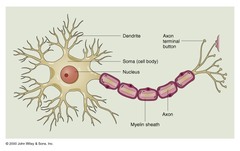Psych Neuron Test
0.0(0)
0.0(0)
Card Sorting
1/18
Earn XP
Description and Tags
Study Analytics
Name | Mastery | Learn | Test | Matching | Spaced |
|---|
No study sessions yet.
19 Terms
1
New cards
Axon
Attached to the soma, the neuron extension that passes messages through its branches to other neurons or to muscles or glands
2
New cards
Dendrites
Bushy, branching extensions that receive and integrate messages, conducting impulses toward the cell body
3
New cards
Soma (cell body and nucleus)
The part of the neuron that contains the nucleus, the cells life-support center
4
New cards
Myelin sheath
The fatty tissue layer segmentally encasing the axons of some neurons; increases transmission speed and provides insulation
5
New cards
Neurotransmitters
Chemical messengers that cross the synaptic gaps between neurons
6
New cards
Acetylcholine (ACh)
Enables muscle action, learning, and memory
7
New cards
Dopamine
Influences movement, learning, attention, and emotion
8
New cards
Serotonin
Affects mood, hunger, sleep, and arousal
9
New cards
Norepinephrine
Helps control alertness and arousal
10
New cards
GABA (gamma-aminobutyric acid)
A major inhibitory neurotransmitter
11
New cards
Glutamate
A major excitatory neurotransmitter; involved in memory
12
New cards
Endorphins
Neurotransmitters that influence the perception of pain or pressure
13
New cards
How neurotransmission works
1. A message travels from the dendrites through the cell body and to the end of the axon.
2. The message causes the chemicals, called neurotransmitters, to be released from the end of the axon into the synapse. The neurotransmitters carry the message with them into the synapse. The synapse is the space between the axon of one neuron and the dendrites of another neuron.
3. The neurotransmitters then travel across the synapse to special places on the dendrites of the next neuron, called receptors. The neurotransmitters fit into the receptors like keys in locks.
4. Once the neurotransmitter has attached to the receptors of the second neuron, the message is passed on.
5. The neurotransmitters are released from the receptors and are either broken down or go back into the axon of the first neuron.
2. The message causes the chemicals, called neurotransmitters, to be released from the end of the axon into the synapse. The neurotransmitters carry the message with them into the synapse. The synapse is the space between the axon of one neuron and the dendrites of another neuron.
3. The neurotransmitters then travel across the synapse to special places on the dendrites of the next neuron, called receptors. The neurotransmitters fit into the receptors like keys in locks.
4. Once the neurotransmitter has attached to the receptors of the second neuron, the message is passed on.
5. The neurotransmitters are released from the receptors and are either broken down or go back into the axon of the first neuron.
14
New cards
Neuron Diagram

15
New cards
Polarization
The resting state of the neuron, charge is more positive outside the membrane and more negative inside
16
New cards
Depolarization
The action potential; the rushing in and out of positively charged ions
17
New cards
Repolarization
The refractory period; the closing of the membrane and reestablishing a more negative charge inside
18
New cards
All-or-nothing response
A neuron's reaction of either firing (with a full-strength response) or not firing.
19
New cards
Reuptake
A neurotransmitter's reabsorption by the sending neuron